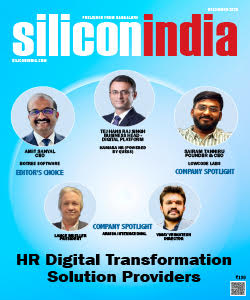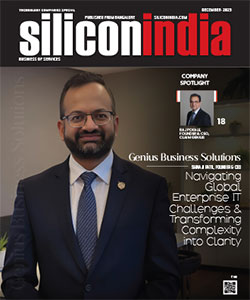Edge computing and the startups that innovate near the edge
![]()
Fuelled by the rise in the number of internet applications and the need for scalability with minimal computing resources, cloud computing has been established for over a decade, in particular, as an enterprise solution in widely different models. Cloud computing is a term given for using remote servers over the internet, for services like data storage, management and processing. However, with the booming interest in the Internet of Things (IoT) and the growing number of internet users, there is a huge amount of data to be processed. With the large volume of data, the question is, “Is Cloud computing the ideal way to handle it?” Answering it, Kumar T, an edge computing expert, says that 'with a massive amount of data being collected from various processes and devices globally, companies are finding themselves spending huge amounts of money for data storage and processing. Data accumulation leads to an increase of such costs in a Fibonacci manner, which is significantly worse than a linear cost increase. Such an approach is therefore highly unscalable. Edge computing is an ideal solution for such a problem, wherein data is processed at data collection sources ("Edges") itself and the only processed information is moved and stored in the cloud''. Hence, relieving the cloud of the data processing requirement significantly reduces the processing costs for enterprises. Moreover, hashed information uses up to 95% lower cloud real estate compared to raw data, thereby saving significant storage costs as well.
Edge computing
For many use-cases such as IoT, that involve a stream of a large amount of sensor data, edge computing offers a much suitable alternative than cloud. Edge computing refers to the IT architecture that processes data near the source of its generation rather than a centralized server or cloud. For instance, an aircraft equipped with Edge capability to monitor critical onboard systems can process the data near the systems and in the event of detection of anomalous data, it can immediately trigger alerts or take smart actions. Primarily, Edge computing network comprises of the following three components:
Sensors – Sensors are the devices that capture raw data from the surroundings, they form the first layer of the Edge network where the information is gathered in real time.
Edge gateway – Edge gateways form the second layer in the network and are the place where data is processed and analyzed. It is either sensor-mounted, or an independent device kept in the vicinity of the sensors. Gateways are more like mini data processing centers that can handle data from multiple devices.
Cloud/Server – The last layer of the network is the Cloud or the main data center. Depending on the use case, a partial amount of data may be processed here or may be used as a repository for data analytics.
Why Edge Computing?
While Edge computing provides numerous benefits over the existing methods of data processing, the capabilities that Edge provides depends on the specific use cases. Regardless, following are the common merits of edge computing over cloud:
Cost-effective – As the amount of data sent to the Cloud or server is reduced by computing at the Edge, enterprises can cut down the operational costs with reduced data usage and bandwidth. Some accounts place a potential to save up to 95% of the cloud costs by using Edge computing practices.
Reduced network latency – Latency is highly undesirable for many time-critical applications such as in an aircraft control system, power grids etc. By having the data processed at the Edge, automated actions can be taken swiftly instead of sending data to a processing facility that is geographically distant and waiting for a response.
Remote operational capability – The low bandwidth requirement of Edge computing would prove useful in situations where internet connectivity issue exists. Additionally, in the event of loss of internet connectivity, Edge platforms can still perform actions as long as sensors remain connected to gateways that are equipped with autonomous capability.
While the prime drivers of innovation in Edge computing are the global market leaders such as IBM, Microsoft, Amazon, Cisco etc., startups too are increasingly becoming competitive and are noteworthy for what they can offer. Following are a few startups that make use of edge computing in their solutions:
Vapor IO
![]()
Based in the US, Vapor IO is a data-driven data center startup that provides a decentralized solution to the existing problem of having centralized data processing server. Focused on solving problems in telecommunications and providing better Cloud computing capabilities, Vapor IO utilizes the concept of Edge computing to set up microdata centers in proximity to cell towers. They provide their patented hardware solution called the Vapor Chamber, an energy efficient server racking system, as well as software solutions called Vapor CORE and Vapor Compass. Vapor IO is backed by investors such as Goldman Sachs and has already completed its series A and B funding rounds.
DiscoveryIoT
![]()
DiscoveryIoT is an IoT and Blockchain based supply chain startup led by Selvam VMS that seeks to provide an innovative solution for the problems faced in the supply chain today. They are building a sophisticated IoT network by creating a community of smartphone users, through which they can track inventories utilizing the Edge computing capability. By developing their own IoT tag named Cliot, they plan to affix it to the items to be tracked. The tag will then communicate with a nearby smartphone that is registered in the network and send the data to the paired phone to process data via edge computing which is further uploaded to the Cloud. They have partnered with I3 (Intelligent IoT Integrator), a consortium led by the University of Southern California, to integrate IoT related edge computing activities on their network. Currently, Discovery is conducting the pre-sale of its DIS tokens which will be followed by ICO rounds starting from September 2018.
ClearBlade
![]()
ClearBlade is an IoT software startup that specializes in providing enterprise IoT solutions. They provide end-to-end services from Edge to Cloud in a flexible Cloud agnostic platform which can be deployed on any vendor clouds or hybrid environments. In addition, their patented AutoSync technology allows data to be synchronized from the edge across all platforms which guarantees an up-to-date environment. ClearBlade has already signed up with customers including Stanley Black & Decker, BNSF Railway and Hudson Yards. In series A funding round led by Align Capital, ClearBlade has raised close to $3 million.



.jpg)